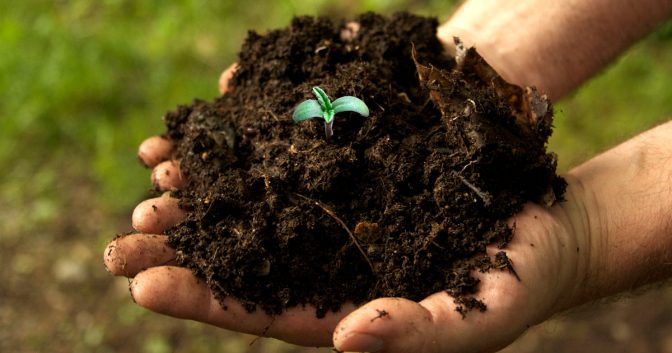7 Steps to Having a Successful Outdoor Cannabis Garden

It’s that time of the year when cultivators start preparing plants for the outdoor season. Here’s what you need to do to get your cannabis garden growing.
1. Choose Your Strains Wisely
Certain strains thrive in certain climates. Sativas like Blue Dream are generally more resistant to high temperatures and humidity levels. They can take up to 14 weeks to flower in the hot climates of the Southwest or Southeast. Indicas like OG Kush, which flower in seven to 10 weeks, are more acclimated to areas like the Midwest or Northeast. They prefer dryer climates. If it rains all summer, you may want to choose a hybrid strain. It’s important to think about your local climate when deciding which strains to grow and when to bring plants outdoors.
2. Don’t Hate, Germinate

Certain strains thrive in certain climates. Sativas like Blue Dream are generally more resistant to high temperatures and humidity levels. They can take up to 14 weeks to flower in the hot climates of the Southwest or Southeast. Indicas like OG Kush, which flower in seven to 10 weeks, are more acclimated to areas like the Midwest or Northeast. They prefer dryer climates. If it rains all summer, you may want to choose a hybrid strain. It’s important to think about your local climate when deciding which strains to grow and when to bring plants outdoors.
Alternatively, you can start with clones from a previous crop or acquire them from a friend or a dispensary. Simply take the cuttings and place them in a soil medium of your choice (see Step 3 below) and let them take root and flourish.

Transplant your seedlings into organic soil.
3. Grow Space and Soil
While the seeds are “popping,” you’ll need to decide whether to plant directly into the ground (assuming you have a backyard or land) or transplant them into 5- or 10-gallon buckets. You’ll also want to consider how much sunlight—you don’t want too little or too much—reaches your selected space. Keep all of nature’s elements in mind when thinking about where you want to grow; for instance, too much wind or torrential rains can damage or drown your plants.
If you do decide to plant directly into the ground, you should test the soil’s pH. It should be between 6.0-7.0.
If you elect to go with buckets, think about the kind of medium you want. Sandy soil is generally more acidic and lower in nutrients, but it holds warmth fairly well. Clay soil has a higher pH level and is jam-packed with nutrients, but tends to have drainage issues. A silty, plant-debris soil is the closest to pH balanced while still providing plenty of nutrients. Whatever medium you choose, be sure to check the pH regularly and test for any contaminants. You can use a soil testing service or order your own kit to make sure that the soil is balanced and free of contaminants.
One final note about choosing a location: The fewer people who know about your grow, the less likely it is that someone will tell someone who’ll tell someone else who may sneak in to your garden and harvest your plants before you do.

Top view of a vegetating plant
4. Bring ’Em Outside
After about a month, the seedlings will turn into small plants with a few sets of leaves. Transplant them again, this time into 5- or 10-gallon buckets. The more room the roots have to dig in, the larger the plants will be able to grow, so the bigger the buckets, the better. Dig a hole in the bucket and, turning the small pot upside down, carefully squeeze its side until the plant comes out. Place them in the buckets and gently pat them down with dirt, and water each bucket generously. Put them in the area that you’ve selected.

These fertilizers will help your plants flower.
5. Fertilizers and Watering
Add organic fertilizers like worm castings, compost and fish meal to the soil before planting and throughout the plant’s life cycle. You can get these products online or at most gardening stores. More plants have died from over-fertilizing than from under-fertilizing. Plants strive to grow, so don’t get in their way. Avoid using soil with heavy fertilizers or time-release fertilizers, which can damage young plants.
How often to water depends entirely upon your climate. A rainy climate may require adding gravel, perlite or clay pebbles to the soil to prevent fungus. A dry climate may require daily watering, especially if the plants are in pots. If the soil’s dry about an inch below the surface, it needs water.
Also, feed the plants liquid fish fertilizer during the vegetative period of pre-flowering growth. The containers list NPK. This stands for nitrogen, phosphorus and potassium. A standard NPK for the vegetative period is 6-3-9. Once the plants start to flower, change the NPK to 3-6-9.

Critters like raccoons like to nibble on cannabis crops.
6. Keep Pests Under Control
You really don’t want to use pesticides, especially close to harvest, but you can’t let garden critters eat away your crop either. Diatomaceous earth is a natural way to keep out pests with hard exoskeletons like cicadas. Simply sprinkle it around the plants.
Grow companion plants like rosemary, marigolds and basil; they contain natural repellents that act as deterrents for pests.

When a plant show «hairs» like this, it’s a female.
7. Sexing Your Plants
Cannabis plants become male or female as they mature. This will generally occur after a few months when the plants get a more balanced sun-to-darkness ratio, which triggers flowering. Males have pods about the size of popcorn seeds where the branch stems connect with the main stalk. A female sprouts two small white hairs, designed to catch pollen, in the same location.

Male cannabis plant
Remove all male plants before they pollinate. This will enable the females to spend their energy producing THC rather than seeds. If you wait too long, the males will pollinate the females and you’ll end up with seedy plants, which is not the goal (unless you’re growing a seed crop). Of course, if you start with clones, you already have females.
WHAT YOU NEED FOR YOUR SPRING GROW
Seeds: Generally available from seed banks in England and Holland for about $10 per seed.
Clones: Purchase at stores in legal states for as low as $15 per clone.
Soil/Mediums: Dirt is cheap ($8.99 for 16 qts.); just make sure it’s organic.
Pots/Buckets: A five-pack of 10-gallon containers costs $37.99 at Amazon. Five-gallon containers sell for as low as $1 each.
Fertilizers: A 15-pound bag of worm castings costs $19. Liquid fish fertilizers that contain seaweed are between $15-$20.
pH Meter: Soil testers run from $10-20 at Amazon.
Pest Control: Bags of diatomaceous earth cost $12-$25.
PLANTING CALENDAR
April 1: Start seeds.
May 1: Transplant seedlings or cloning tray to a 1-3 gallon soil container.
June 1: Transplant into 5- or 10-gallon buckets. Move outdoors, as the sun’s light-cycle is long enough to keep the plants in vegetative growth.
August 1: Switch to bloom fertilizer.
Related Articles
High Times Article Leads Feds to Massachusetts Grow Ops
Slowly But Surely, Cannabis Licenses Are Being Issued in Jamaica
Netanyahu Shuts Down Israel’s Cannabis Import Plan
Seed-to-Sale Tracking: How It Works
This article was written by the Denver-based Green CulturED, which provides eLearning solutions for the cannabis industry.
